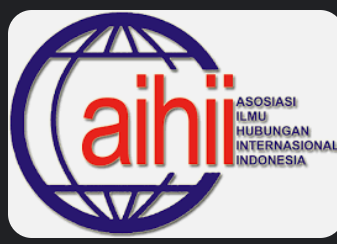From Southeast Asia to Indo-Pacific: How Far Indonesian Geostrategic Doctrine Shapes Its Position
DOI:
https://doi.org/10.33822/mjihi.v4i1.2187Kata Kunci:
geostrategic doctrine, national resilience, middle power countries, Southeast Asia, Indo-Pacific, IndonesiaAbstrak
Geographically, Indonesia is one of country that has so many potentials. With its location between two continents and oceans, Indonesia could make strategic role in region and the world. Geostrategy of one country play an important role to its foreign policy and diplomacy. Indonesia has ‘national resilience’ as the national geostrategic doctrine. It will be interesting to study how far that geostrategic doctrine influences international relations of Indonesia. This study will discuss in several parts, from the role of Indonesia as a part of middle-power countries in different government administration to the position of Indonesia in the region because of its geostrategic doctrine.Referensi
Acharya, A. (2015). Indonesia Matters: Asia’s Emerging Democratic Power. Singapore: World Scientific Publishing.
Bajpai, K., & Chong, B. (2019). India's Foreign Policy Capacity. Policy Design and Practice, 2(2), 137-162. doi:10.1080/25741292.2019.1615164
Bellamy, A. J., & Beeson, M. (2010). The Responsibility to Protect in Southeast Asia: Can ASEAN Reconcile Humanitarianism and Sovereignty? Asian Security, 6(3), 262-279. doi:10.1080/14799855.2010.507414
Chapnick, A. (1999). The middle power. Canadian Foreign Policy Journal, 7(2), 73-82. doi:10.1080/11926422.1999.9673212
Cooper, A. F., Higgott, R. A., & Nossal, K. R. (1993). Relocating Middle Powers: Australia and Canada in a Changing World Order. Vancouver: UBC Press.
Databoks. (2018, August 13). Tenaga Kerja Asing di Indonesia Bertambah 3.800 Orang. Retrieved from Katadata.co.id: https://databoks.katadata.co.id/datapublish/2018/08/13/tenaga-kerja-asing-di-indonesia-bertambah-3800-orang
Heiduk, F. (2016). Indonesia in ASEAN: Regional Leadership between Ambition and Ambiguity. Berlin: German Institute for International and Security Affairs, SWP.
Hidayatullah, N. L. (2017). Indonesia's Role as a Middle Power: a Neo-Liberalist and Constructivist Analysis. Airlangga University, Department of International Relations. Surabaya: Airlangga University. Retrieved from http://repository.unair.ac.id/id/eprint/68192
Holbraad, C. (1984). Middle Powers in International Politics. London: Palgrave Macmillan UK. doi:10.1007/978-1-349-06865-4
IISS. (2018). Military Balance 2018. London: International Institute for Strategic Studies.
Jongryn, M. (2015). Introduction: G20 Middle Powers (MIKTA) and Global Governance. In M. Jongryn (Ed.), MIKTA, Middle Powers, and New Dynamics of Global Governance (pp. 1-12). New York: Palgrave Macmillan. doi:10.1057/9781137506467.0004
Jordaan, E. (2003). The Concept of a Middle Power in International Relations: Distinguishing between Emerging and Traditional Middle Powers. Politikon: South African Journal of Political Studies, 30(1), 165-181. doi:10.1080/0258934032000147282
Karim, M. F. (2018). Middle power, status-seeking and role conceptions: the cases of Indonesia and South Korea. Australian Journal of International Affairs, 72(4), 343–363. doi:10.1080/10357718.2018.1443428
Keethaponcalan, S. I. (2016, October 4). Reshaping the Non-Aligned Movement: Challenges and Vision. Bandung: Journal of the Global South, 3(1), 1-14. doi:10.1186/s40728-016-0032-3
Kim, C. W. (2009). Middle power as unit of analysis of international relations: its conceptualizations and implications. The Korean Journal of International Relations, 1, 7-36.
Lemhannas RI. (2010, July 20). Visit of the Governor of Lemhannas RI to the United Kingdom in the Framework of PPRA XLIV. Newsletter, p. 9.
Lowy Institute. (2019). Asia Power Index 2019. Sydney: Lowy Institute.
McClory, J. (2019). The Soft Power 30 : A Global Ranking of Soft Power 2019. London: Portland Communications.
Nye, J. S. (2011). The Future of Power. New York: PublicAffairs.
Poling, G. B. (2013, March 8). Dynamic Equilibrium: Indonesia’s Blueprint for a 21st Century Asia Pacific. Retrieved from CSIS: https://www.csis.org/analysis/dynamic-equilibrium-indonesia%E2%80%99s-blueprint-21st-century-asia-pacific
Priyono, J., Herman, & Yusgiantoro, P. (2017). Falsification Test of the National Resilience Concept as Indonesian Geostrategic Doctrine. Journal of Defense & State Defense, 7(2), 121-136.
Putra, B. A. (2015). Indonesia's Leadership Role in ASEAN: History and Future Prospects. International E-journal of Advances in Social Sciences, 1(2), 188-197. doi:10.18769/ijasos.82584
Santikajaya, A. (2017). Walking the middle path: The characteristics of Indonesia’s rise. International Journal, 71(4), 563–586. doi:10.1177/0020702016686381
Soekarno. (1965). Susunlah Pertahanan Nasional Bersendikan Karakteristik Bangsa. Djakarta: Pertjetakan Negara RI.
Suradinata, E., & Dinuth, A. (2001). Geopolitik dan Konsepsi Ketahanan Nasional: Pemikiran Awal, Pengembangan, dan Prospek. Jakarta: PT Paradigma Cipta Yatsigama.
Suryadarma, D. (2013, October-December). Can Indonesia educate itself out of middle-income status? (A. MacIntyre, & M. M. Wihardja, Eds.) East Asia Forum Quarterly, 5(4), pp. 26-27. doi:10.22459/EAFQ.05.04.2013





